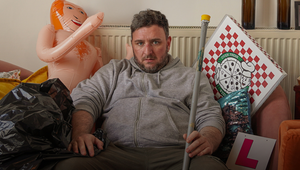
Bring Sexy Back

This season’s fashion, posited a recent piece in i-D Magazine, is all about boobs. And it’s not just fashion. In contemporary art, boobs are once more appearing en masse, the none too subtle sign that audiences are looking for the solace that only comes from getting down and dirty. For advertisers, art and fashion’s new mammary focus is a little cultural canary in the mine that the emotional mood has changed, and that to connect with emotion we should be looking beyond tear jerking and magical moments to a raunchier emotional landscape.
Had you walked into the blue chip hush of Hauser & Wirth’s Savile Row galleries last month you would have been met by the madly happy, cartoonish faces that the artist George Condo has made his own in a show of work made during lockdown in New York last year. Canvases of bright colours, googly eyes and toothy smiles embodied the artist's celebrated self reflective, diarising style and amidst the paint splattered jollity, were breasts galore.

© George Condo / Photo: Alex Delfanne
The frenzied happiness of Condo’s ‘The Day They All Got Out” (2020)’ with its bright splashing colours, free floating, disembodied breasts, naked torsos and splattered paint is jubilant, jangling, unsettled, and straight out horny, capturing the heady, first days of the “hot vax summer”. The frenzied parties in parks and atavistic pent-up urge to connect with others is present in almost every canvas in the show, with disembodied breasts and bodies capturing the giddy, blinkered yearning that comes from desire restrained and experiencing connection only through screens and disembodied images.
As in art, so in fashion. The ‘Dopamine Dressing’ trend saw acid bright head-to-toe colour on almost every runway. Built on the Y2K fashion revival and its opportunities for the barely-there micro cardigans, bustiers, pelmet mini skirts and transparency last seen when George Bush was in power, the trends at first seem almost cartoonishly sexualised. Runways were filled with body positive models in hot pinks, canary yellows, bright blues and reds, flashing legs, teeth and above all, cleavages in a remarkably retrograde way that seemed to jar with ideas about gaze until you saw the high voltage intent of the poses behind the push ups. These aren’t clothes for the objectified woman of the ‘90s; this is raw sexuality in the hands of a new generation, and its success reveals a truth about the time we live in.
Fashion, as the word implies, captures moments, fleeting desires and trends, and sells us the apparel to embody them. This season those designers who have best responded to this bright, fun, sexy mood have been remarkably commercially successful and the same is true in the art world. Last month’s news that Condo, along with his fellows in cartoonish and graphic execution, the artists Basquiat, Banksy, Yoshimoto NARA, and the NFT star Beeple, were alone responsible for 32% of all of 2020’s art auction sales between them, seems to suggest that simple, direct emotional connection is selling, and selling well. But it’s not the moment for advertising that captivates with profound and moving feelings. Instead, it’s the moment for us as advertisers to deploy a different kind of humanity in the work we share with the world. By which I mean boobs, kind of.
The argument for the creation of emotionally charged advertising work is one that was long ago won, but in creating emotional work we so often focus on the sentimental, the maternal, the soft.
Decision making theorists from Kahneman and Tversky to Damasio and Thaler all propose versions of the idea that when we are overwhelmed by the volume of thinking needed to survive we fall back on our most basic instincts. Yet if, in these exhausting times we are drawn to expressions of self that reflect the relief of finding respite in joy with another, why wouldn’t advertising reflect that need? Perhaps, to connect with tired people in this tiring moment, the most humane response might need us to think more literally, to lift the burden and reflect the uplifting simplicity of our most basic needs; shelter, joy, and yes, sexy times.















